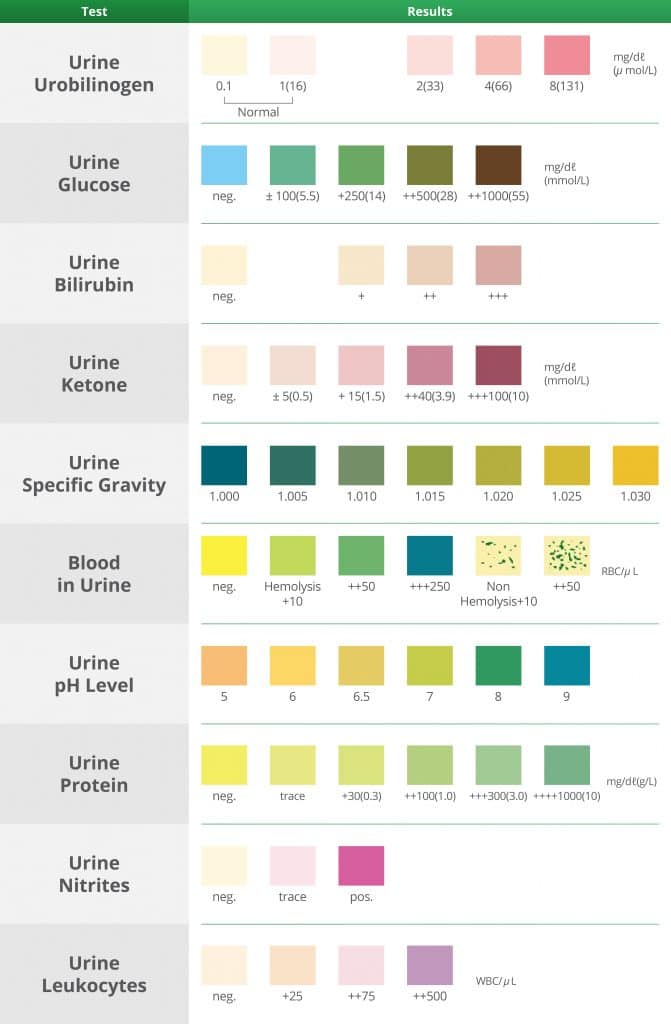What is a urine dipstick test?
A urine dipstick test is an example of a ‘screening test’. This means it is relatively non-specific test that looks for groups of diseases – rather than specific diseases themselves.
It may give the doctor more information on what further tests are required, even if it cannot make a clear diagnosis itself. It is also called a urinalysis.
The main substances tested for are:
- Blood – kidney, bladder (or prostate in a man) disease
- Glucose (sugar) – looking for diabetes
- Protein – chronic kidney disease (CKD) – especially involving the glomeruli (tiny filtering units), especially chronic glomerulonephritis and diabetic nephropathy
- White cells and nitrites – urine infection
- Ketones – can be raised in diabetes
- Bilirubin and urobilinogen – liver disease.
So. How is it done?
A dipstick is the quickest way to test urine. It involves dipping a specially treated paper strip into a sample of your urine. This can be done during your appointment with your doctor, midwife or other health professional.

The results are usually available within 60-120 seconds. Your sample doesn’t need to be sent to a laboratory for a urine dipstick test, although if the test is abnormal you might need to do another sample to be sent for further testing in a laboratory.
Why is a urine dipstick test done?
A urine dipstick test is done for lots of different reasons, such as:
- A routine check when you’re pregnant
- To look for diabetes
- If you think you might have a urine infection
- If you have tummy (abdominal) or back pain
- If you think you’ve seen blood in your urine (haematuria)
- Some people with diabetes will do their own urine dipstick testing routinely.
What does a urine dipstick test for?
A urine dipstick test can look for the following:
Blood
- Not normally found in the urine
- May be present if there is an infection
- Can be due to significant underlying disease, such as cancer, in the bladder or kidney (and the prostate gland in men)
- In women, it may be contamination if you are on your period at the time of doing the sample
- Will always need to be confirmed by sending the sample for a full laboratory test, as the dipstick test can be positive when there’s nothing wrong.
Glucose
- Glucose, a type of sugar, is not normally found in the urine.
- The only exception is if you have type 2 diabetes and are taking a medicine called an SGLT2 inhibitor (such as canagliflozin, dapagliflozin, empagliflozin or ertugliflozin). These medicines can help reduce your blood sugar partly by increasing the glucose lost in the urine. Having glucose in your urine if you’re taking one of these medicines is normal.
- Glucose in the urine may be the first sign of diabetes.
Protein
- Protein is normally found in the urine only in tiny amounts; but these tiny amounts aren’t usually picked up on a urine dipstick test
- Protein may be found in larger amounts if there is an infection or if you’re pregnant and are developing pre-eclampsia
- Can be the first sign of chronic kidney disease (CKD), glomerulonephritis or nephrotic syndrome.
“Heavy proteinuria (3+ or more on a dipstick) is the hallmark of damage to the glomeruli (glomerular disease) “
Leukocytes (white blood cells) and nitrites
- These are both tests for the presence of urine infection
- The leukocyte test is only positive if there are lots of white cells in the urine. White cells get into the urine when there is an infection
- Nitrite is not normally found in the urine but will appear there if there are lots of germs (bacteria) in the urine
- Nitrite test can be negative even if there are lots of bacteria in the urine if the urine hasn’t been in the bladder for long. For example it will be negative if you do your urine sample soon after having passed urine. Ideally you should wait at least four hours from the last time you had a pee before doing your urine sample.
Ketones
- Ketones are not usually found in the urine
- Ketones may be present if you have diabetes and it’s out of control and the levels of glucose in the blood are very high
- Ketones may also be present in women who are pregnant.
Bilirubin and urobilinogen
- Bilirubin and urobilinogen are chemicals produced by the liver. They are not normally found in the urine
- If bilirubin is found in the urine it usually means there’s a problem with the liver
- Small amounts of urobilinogen may be found in the urine but large amounts suggest a problem with the liver or with red blood cells being destroyed too quickly.
The urine dipstick test also measures how concentrated the urine is and how acidic it is.
How to read a urine dipstick
The paper strip is put against a colour chart below. Different makes are slightly different.

Summary
We have described what is a urine dipstick test, and what it is used for. We hope it has been helpful.
Last Reviewed on 16 July 2024
